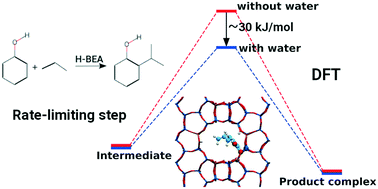DFT study of phenol alkylation with propylene on H-BEA in the absence and presence of water†
Abstract
We employ ab initio density functional theory calculations to investigate the mechanisms of phenol (a model compound for lignin-derived bio-oil) alkylation with propylene to 2-isopropylphenol, in the presence and absence of water on H-BEA. We also compute the reaction pathways for phenol alkylation in the uncatalyzed gas phase to understand H-BEA catalysis. In the uncatalyzed gas phase, phenol acts as a self-catalyst, activating propylene by transferring a proton from phenolic oxygen and facilitating the carbon–carbon bond formation reaction. We find that the lowest barrier process proceeds via an intermediate both in the uncatalyzed gas phase and on dry H-BEA. On H-BEA, the intermediate is stabilized by the transfer of a zeolitic proton. Our calculations show that, in comparison to the uncatalyzed gas phase, H-BEA reduces the barrier for converting the reactant complex to the intermediate by ∼40 kJ mol−1, which translates to a four order-of-magnitude increase in the transition-state theory rate coefficient at 350 °C. However, we find that the rate coefficient for the next step, which is also the rate-limiting step, remains unchanged on H-BEA. We further find that the presence of water reduces the activation barrier for this step—i.e., the rate-limiting step—by ∼30 kJ mol−1, which leads to a two order-of-magnitude increase in the transition-state theory rate coefficient at 350 °C.

- This article is part of the themed collection: Emerging Investigator Series


 Please wait while we load your content...
Please wait while we load your content...